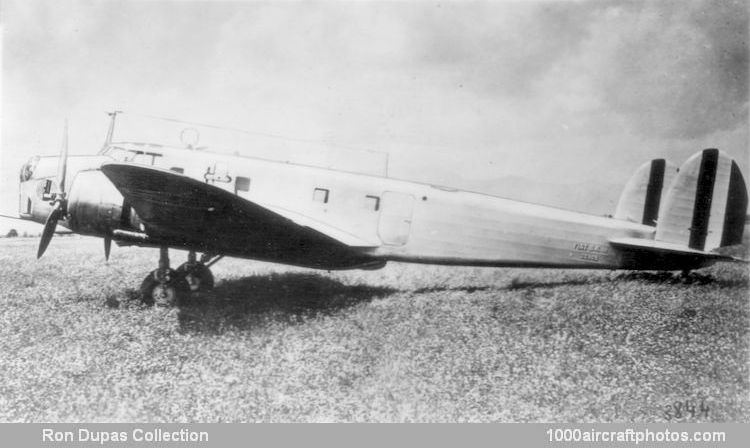04/30/2019. Remarks by Johan Visschedijk: "The B.R.20 medium bomber became one of the best-known Italian bombers but did not actually play a very important role in Italian AF operations during WW II. Following the modern concept of twin-engined bombing monoplanes, the B.R.20 embraced nearly every design advance current in 1936. In spite of a somewhat angular fuselage, the B.R.20 possessed relatively clean lines, with low-mounted cantilever wing and retractable landing gear. Power was supplied by Fiat A.80 R.C.41 eighteen-cylinder radial engines of 1,000 hp each. Armament of the original production model comprised three 0.50 in (12.7 mm), machine guns in nose and dorsal turrets and a ventral position.
In 1937 the B.R.20A civil record plane was flown for the first time, two entering in the Istres-Damascus-Paris air race later that year. Due to the lack of armament the empty weight was less at, but an increased fuel load boosted the all-up figure. In 1939 the Santo Francesco, another civil model officially designated B.R.20L, was built for a record run from Guidonia to Addis Ababa, Italian East Africa (presently Ethiopia). Piloted by Maner Lualdi, Giuseppe Mazzochi, and E. Valente, assisted by two crew members, the Santo Francesco flew the distance of 2,772 mls (4,461 km) non-stop on March 6-7, 1939, at an average speed of 242.9 mph (390.9 kmh).
The first production examples were tested under operational conditions in Spain in 1937. At the same time the Japanese government, after evaluating both the Caproni Ca 135 and the B.R.20 for use with the Japanese AAF in China, ordered 100 of the latter to supplant the aging Mitsubishi Ki-1 Type 93 heavy bombers. Designated Type I (Italy), Model 100 by the Japanese, about 75 of the Fiat bombers were supplied in early 1938 in exchange for Manchurian soy beans. In actual combat over China, the Type I bombers were considered unwieldy, poorly armed and easily susceptible to fire because of the fabric covered wings. After generally unsuccessful operations, the Fiats were completely replaced by the new Mitsubishi Ki-21 Type 97 bombers in 1939. A few B.R.20s were purchased by Venezuela in the late 1930s after the establishment of an Italian Air Mission in that country.
The production B.R.20 bombers, named Cicogna (Stork), had gone into service with the Italian AF between 1936 and 1940, approximately 275 examples being delivered. On June 10, 1940, 219 B.R.20s, of which 132 were serviceable, equipped four bomber wings. During the war Cicognas also served with an observation group of the Italian Expeditionary Corps in Russia.
The B.R.20 was considered primarily a night bomber and later a reconnaissance plane; in any case its exploits did not compare with those of the Savoia-Marchetti SM.79 and CANT Z.1007, which formed the backbone of the Italian bombing force. In October and November, 1940, B.R.20s based in Belgium as a part of the expeditionary Italian Air Corps, participated to a limited extent in the Battle of Britain, making only two daylight attacks and a few night raids, all unsuccessful. Subsequently the Cicogna served over Greece and North Africa.
The B.R.20M (for Modificato, modification), which appeared in 1939, was an improved bomber incorporating experienced gained in the Spanish Civil War. Employing the same A.80 R.C.41 engines, the B.R.20M featured improved crew protection and modified armament, including an aerodynamically cleaner nose design. The Agusta factory experimentally fitted one B.R.20 with tricycle landing year, the first Italian military aircraft so equipped.
The final development of the B.R.20, and the first to differ extensively from the 1936 prototype, was the B.R.20bis, flown for the first time in 1941. Major changes included the fitting of 1,250 hp Fiat A.82 R.C.42S radials in much refined cowlings, greatly improved fuselage aerodynamics, and an increased defensive armament of five machine guns, the three 0.50 in (12.7 mm) weapons being supplemented by two 0.303 in (7.7 mm) guns in lateral blisters. Only a limited number of the B.R.20bis were delivered to the Italian AF, total production of the B.R.20M and B.R.20bis being approximately 250 machines. By September, 1943, only 67 Cicognas of all variants remained in service.
Pictured above is the first of the initial batch of twenty production aircraft. Serialed MM20305 to MM10324, these were delivered from October 1936 to February 1937."
